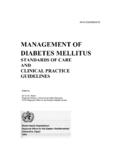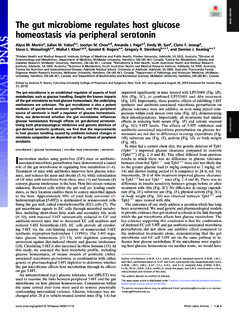Transcription of STANDARD OPERATING PROCEDURE FOR NOVA STAT …
1 STANDARD OPERATING PROCEDURE FOR nova STAT STRIP. CONNECTIVITY blood glucose METERS FOR USE IN LEEDS. NHS TRUST. This STANDARD OPERATING PROCEDURE explains the protocol for measuring blood glucose concentration using the nova Stat Strip Connectivity meters, with emphasis placed on the responsibility of nursing staff/HCAS to ensure that the meter is used correctly and that a high STANDARD of patient and control results is maintained. OPERATORS: Only staff who have received documented training (by nova trainers or by ward Key Trainers) are authorised to use the meters. Copies of training records must be kept in clinical areas and be available for scrutiny if requested. Names of staff trained, trainer, date, location (ward/Hospital), and password must be sent to the Point of Care Manager in Biochemistry, LGI by e- mail - Group address Point of Care , for the password to be made active.
2 TRAINING: Training sessions will initially be run by nova . Each area must have trained members of staff who are designated to cascade training to new/untrained staff. CLINICAL RELEVANCE. Simple and quick method to test for glucose in blood PRINCIPLE OF TEST. glucose dehydrogenase is impregnated into the test area of a reagent strip (also called an electrode). This reacts with the glucose present in a blood sample and produces an electrical signal. This is detected by the meter and translated into a glucose result in mmo/L. The strength of signal produced is directly proportional to the amount of glucose in the blood . EQUIPMENT. Stat Strip Connectivity Meter and Docking Station and Work Station Stat Strip glucose Test Strips, 50 strips per vial ..42214. Stat Strip glucose Control Solution, Level 1(low), one vial.
3 41741. Stat Strip glucose Control Solution, Level 3(high), one vial .. 41743. The strips are obtained from Pharmacy. Control solutions are also supplied by Pharmacy. Other accessories: 43607 Sterility Bags (100) per box per box 44375 Tube Dispenser 5ml (pk50) glucose Meter per box Order direct from nova Biomedical UK, C3-5 Evans Business Centre, Deeside Industrial Park, Deeside, Flintshire, CH5 2JZ. BIMENSG1 v 3. Page 1 of 6. Users will also require equipment for obtaining a capillary finger or heel prick sample, NB Connectivity Meters are not replaced free, so a new meter will have to be purchased to replace lost or damaged meters MAINTENANCE/HOUSEKEEPING. 1. Test Strip /Sensor Electrodes 50 test strips/ electrodes per pot. Each pot should have barcode clearly visible on it. Spaces for date opened, by whom and expiry date MUST be completed (6 months/180 days).
4 One full pot and one pot in use should be kept in workstation. Spare pots should be kept in store cupboard at room temperature as required. Discard pot and any remaining electrodes 3 months/90 days after opening. 2. Control Solutions (High/Low). Check the expiry date on the bottles and ensure it is in date. When new bottle is opened the expiry date MUST be written in the space provided (3 months, 90 days). Discard bottle 3 months, 90 days after opening, even if it is not empty 3. Faults If the meter is faulty, contact 22338 LGI or 64791 SJUH, or Bleep 2320. 4. Quality Control (QC). Two QC samples, Level one (Low) and Level 3 (High) MUST be performed satisfactorily, once every 24 hours by a member of the ward/dept staff on duty. If this is not done, the meter will lock out users, until satisfactory QC is performed.
5 5. External Quality Assurance (WEQAS). These samples are distributed in a brown envelope on a THREE. MONTHLY basis, and MUST be analysed as instructed. In areas where there is more than one meter, all meters in the ward/dept should be tested. This is a mandatory requirement. BIMENSG1 v 3. Page 2 of 6. ANALYTICAL PROCEDURE . To analyse a Patient sample (Important: only trained staff may use the glucose meters. Access to the meter is by scanning personal Trust ID badge. Use of someone else's password may result in disciplinary action). Remove meter from docking station. Wash patients hand or heel with water and dry thoroughly. Alternatively use alcohol pads to clean area; dry thoroughly after cleaning. Holding hand downward, massage finger with thumb toward tip to stimulate blood flow. Press Login . Press Scan whilst pointing bar code reader at your own Trust ID badge barcode.
6 From the Patient Test screen press Accept . Enter Strip Lot screen is displayed. Scan the strip lot number from the side of the strip container. Press Accept . Enter the patient's ID by scanning their addressograph label barcode, or enter Hospital Case note number using the keypad. If this is not available use the keypad to enter full patient name. Please be aware that glucose results from the meters are stored on computer and MUST be traceable to the patient. Press Accept . Use a safety lancet to puncture the finger and squeeze the finger to form a drop of blood . Prick the side of the patient's finger. Remember not to use the thumb or index finger. Follow instructions on the screen to perform test. Result will appear in 6 seconds. To add a comment before accepting or rejecting the result, press the Comment key.
7 Accept your comment and then accept or reject the result. A comment must always be added if rejecting a result. The result must be entered in the patient's notes, and the appropriate action taken if any. BIMENSG1 v 3. Page 3 of 6. Return meter to the Docking Station. To analyse Quality Control (QC) samples Remove meter from docking station. Press Login . Press Scan whilst pointing bar code reader at your own Trust ID badge barcode. From Patient Test Screen press QC key. Enter Strip Lot screen is displayed. Scan the strip lot number from the side of the strip container. Press Accept . Scan the QC lot No. Press Accept . Follow the on-screen instructions to perform the test. Make sure the QC. bottle is mixed thoroughly before sampling. Result will appear in 6 seconds, if test has Passed , press Accept . If test has Failed check your Strips and QC solution have not exceeded the 90 day expiry.
8 If expired, run the test again with fresh test strips/QCsolution. Make sure the QC bottle is mixed thoroughly before sampling. If it fails again, report failure to POCT 22338(LGI) or 64791. (SJUH), bleep 2320, who will advise you further. REFERENCE RANGE / ACTION LIMITS. Reference range: - mmol/L (Fasting). Action limits:- Neonatal: Less than or Greater than Non-neonatal: Less than or greater than 20 mmol/L. BIMENSG1 v 3. Page 4 of 6. LIMITATIONS. All POCT devices have limitations and this should be remembered at all times. A diagnosis of diabetes or hypoglycaemia cannot be made by blood glucose sensor reading alone. A confirmatory sample must be sent to the laboratory for analysis. All results need to be interpreted in the light of the patient's condition. If an unexpectedly high or low glucose concentration is obtained, a repeat test should be performed and a sample sent to the laboratory.
9 HEALTH AND SAFETY. COSHH REGULATIONS. glucose Sensors The reagent area of each electrode contains: glucose Oxidase - No Risk Non-reactive ingredients - No Risk glucose Control Solutions glucose - Low Risk Non-reactive ingredients - Low Risk Do not swallow or inject the solution. Wear gloves throughout. Disposal: Particular care should be taken to ensure that lancets and used electrodes are disposed of in a sharps container. Cleaning: The Stat Strip meter should not require much cleaning, as with correct use, blood and control solutions do not enter the meter. However, if the meter does get dirty it can be wiped with a damp cloth and mild soap/detergent. Do not immerse or place the meter in water. Infection control: Wear gloves Disposable covers are available for meters in use for patients with infections BIMENSG1 v 3.
10 Page 5 of 6. SELF- monitoring BY IN-PATIENTS. Patients with diabetes admitted to hospital may be monitoring their own blood glucose levels using one of a number of different systems. However, the hospital and its staff have an over-riding duty of care to patients and they must be confident that the blood glucose results obtained are accurate so that they can act appropriately on them. For this reason only test results obtained using the ward Stat Strips must be used to modify treatment in any way. This PROCEDURE was prepared by Robert Coleman, POCT Manager and Dr Joan Pearson, POCT Clinical Lead. Clinical Biochemistry, LTHT. November 2009. BIMENSG1 v 3. Page 6 of 6.




